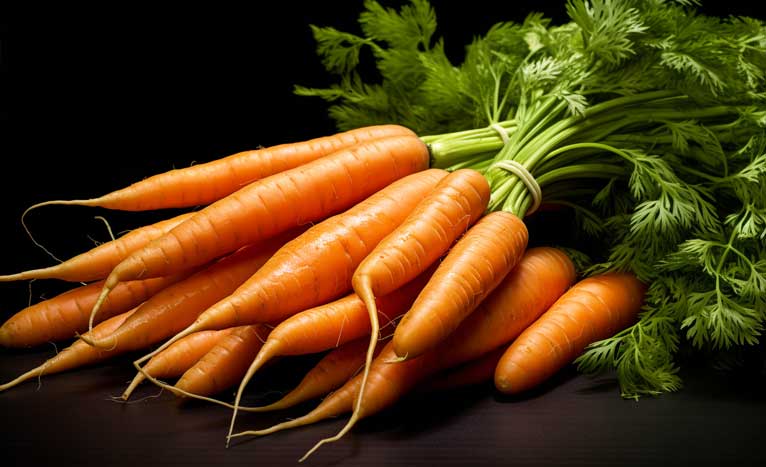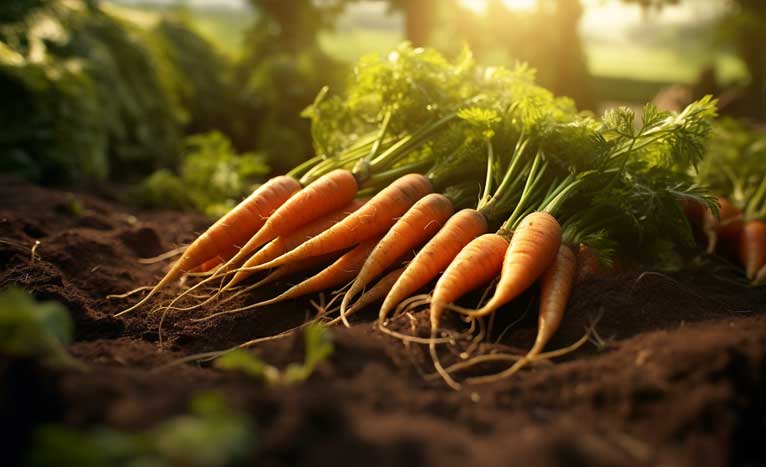Carrots are not only delicious and versatile in the kitchen, but they are also relatively easy to grow in your own backyard. Whether you have a sprawling garden or just a small balcony, cultivating carrots can be a rewarding experience. In this blog, I will walk you through the step-by-step process of growing carrots, from selecting the right varieties to harvesting the perfect orange beauties.
Seriously, if you eat carrots and want to grow them, don’t buy transplants! They are so expensive at nurseries compared to just getting a packet of seeds. Here, I could get a transplant of 6 carrots for five times the price of a packet of carrot seeds—talk about a mark-up! Especially when carrots are so dang easy to grow in your garden, trust me.
I love growing carrots in my homestead garden, so let’s dive in!
Choosing the Right Carrot Varieties
When it comes to selecting carrot varieties, you have a wide range of options to choose from. Some popular choices include Nantes, Danvers, Chantenay, and baby carrots. Nantes carrots are known for their sweetness and crispiness, making them perfect for fresh eating. Danvers carrots have a distinctive conical shape and are excellent for juicing and cooking. Chantenay carrots are short and stubby, which makes them ideal for heavy soils. Baby carrots, on the other hand, are small, bite-sized carrots that are great for snacking and can be harvested early.
I would suggest, as always, to discuss with local gardeners what kind of varieties of carrots they grow. Local gardeners will be seasoned and know what kind of carrots grow best in your region. Maybe you can get lucky and score some local heritage carrot seeds!

Choosing the Right Time for Planting Carrots
To maximize the chances of a successful carrot harvest, it's crucial to select the appropriate time for planting. Several factors should be taken into consideration when deciding when to sow carrot seeds.
Factors to Consider
Climate: Carrots thrive in cool weather, making them ideal for spring and fall planting. They prefer temperatures between 60°F (15°C) and 75°F (24°C). Avoid planting in hot summer months.
Frost Dates: Carrots can tolerate light frost, but freezing temperatures can damage or kill the plants. Determine the last spring frost date and the first fall frost date in your region to plan your planting schedule accordingly.
Growing Season: Carrots have different maturation times, ranging from 50 to 80 days. Consider the length of your growing season to ensure sufficient time for the carrots to reach maturity.
Preparing the Soil for Carrot Planting
Preparing the soil is crucial for successful carrot growth. Start by clearing the area of any weeds or debris. Loosen the soil using a garden fork or tiller, ensuring it is well-drained. To improve soil fertility and drainage, incorporate compost or well-rotted manure. Smooth the soil surface with a rake, removing any large clumps or rocks that could impede carrot growth.
It is incredibly important to have well-draining soil. If you don’t have well-draining soil, especially with carrots, the water will just pool at the surface and not penetrate down in the soil where it needs to be. I ran into this issue in a quarter of my raised garden bed and had to go in and loosen up the soil and add some amendments (my cow’s manure.)
Planting Carrot Seeds
Now it's time to sow the carrot seeds. Create shallow furrows in the prepared soil, spacing them about 1 inch apart. Thinly sow the carrot seeds along the furrows, ensuring they are evenly distributed. Cover the seeds with a thin layer of soil or compost, and gently water the area to ensure good seed-to-soil contact.
Watering and Mulching Carrot Beds
Carrots require consistent moisture to grow properly. Water the carrot beds regularly, keeping the soil consistently moist but not waterlogged. Applying a layer of organic mulch, such as straw or wood chips, helps retain moisture in the soil and suppresses weed growth. Mulching also helps regulate soil temperature, keeping it cool during hot summer months.
Thinning Carrot Seedlings
Thinning is a crucial step in growing carrots, as it provides sufficient space for the remaining seedlings to develop properly. When the carrot seedlings are about 1-2 inches tall, thin them to a spacing of 2-3 inches apart. Gently pull out the weaker seedlings, leaving only the healthiest ones. Thinning ensures that each carrot plant has enough room to grow and access to nutrients.
Protecting Carrots from Pests and Diseases
Carrots can be susceptible to pests and diseases, but with proper preventive measures, you can minimize the risk. Use row covers or netting to protect young seedlings from pests like carrot flies. These covers act as a physical barrier, preventing the flies from laying eggs on the plants. Additionally, rotating your carrot crops yearly helps prevent the buildup of soil-borne diseases. It's also important to keep the garden clean and remove any diseased plants promptly to prevent the spread of infections.
I haven’t had any issues with pests in my area with carrots, and I attribute that to rotating where I plant carrots yearly—this keeps pests confused as they return to the area where they know there were carrots but they’re not there!
Fertilizing Carrot Plants
While carrots don't require heavy fertilization, providing them with some additional nutrients can promote healthy growth. Before planting, incorporate a balanced organic fertilizer into the soil. Avoid using high-nitrogen fertilizers as they can cause forked or misshapen carrots. As the carrot plants grow, you can side-dress them with compost or a slow-release organic fertilizer to provide a gentle nutrient boost.
Carrot Care and Maintenance
Proper care and maintenance are essential for the successful growth of carrots. Keep the soil consistently moist, especially during hot and dry periods, as carrot roots can become tough and woody if they experience water stress. Regular weeding is crucial to prevent competition for nutrients and water. Providing adequate spacing between carrot rows ensures proper air circulation, reducing the risk of diseases.
I would suggest weeding the carrot bed daily. If you get lazy, like I sometimes have, and don’t visit for a few days, you will be surprised at the weed disaster you stumble back into when you revisit the carrots! Take a few minutes each day and it will save you time in the long run.
Harvesting Carrots at Their Peak
Knowing when to harvest your carrots is key to enjoying their flavor and texture. Carrots are ready to harvest when they have reached the desired size and color specified for the variety you planted. To harvest, gently loosen the soil around the carrots and carefully pull them out. Remove the leafy tops, leaving about an inch of stem for easier storage. Freshly harvested carrots are packed with sweetness and flavor, making them a delightful addition to your meals.
Storing and Using Carrots
Proper storage ensures that your carrots stay fresh and flavorful for longer. After harvesting, remove any excess soil from the carrots. Store them in a cool, dark place with high humidity, such as a cellar or refrigerator. Carrots can be used in a variety of dishes, including soups, salads, stir-fries, and even desserts. Their natural sweetness adds a delightful taste to any recipe.
Common Carrot Growing Problems and Solutions
While growing carrots can be relatively straightforward, you may encounter a few challenges along the way. Here are some common problems and their solutions:
Carrot Rust Fly: Use floating row covers to protect the plants from this pesky pest. The covers create a barrier that prevents the flies from reaching the plants and laying eggs.
Carrot Blight: To prevent carrot blight, it is important to rotate your carrot crops yearly. This practice helps break the disease cycle and reduces the chances of infection.
Carrot Cracking: Inconsistent watering or sudden heavy rainfall can cause carrot roots to crack. To avoid this problem, maintain consistent moisture levels by watering regularly.
Fun Facts About Carrots
Carrots have a fascinating history and some intriguing facts associated with them. Here are a few interesting tidbits:
Carrots were originally purple or white, not orange. The orange color we associate with carrots today was developed through selective breeding.
Carrots are an excellent source of vitamin A, which is important for maintaining healthy vision.
The world's heaviest carrot weighed over 20 pounds! That's one massive carrot.
Growing your own carrots can be a delightful and rewarding experience. By following the step-by-step instructions outlined in my blog, you'll be able to cultivate delicious and nutritious carrots right in your own backyard. Remember to choose the right varieties, prepare the soil properly, and provide adequate care throughout the growing season. So, grab your gardening tools and embark on the journey of growing your own carrots – crispy, sweet, and oh-so-satisfying!
Frequently Asked Questions
Can I grow carrots in containers?
Yes, you can grow carrots in containers as long as they are deep enough to accommodate the root development.
How long does it take for carrots to germinate?
Carrot seeds usually take around 14-21 days to germinate, depending on the variety and growing conditions.
Can I plant carrots in the shade?
Carrots prefer full sun but can tolerate some shade. However, they may not grow as large or develop their characteristic sweetness in shaded areas.
What should I do if my carrots are too small?
If your carrots are small in size, ensure they have enough space to grow by thinning them appropriately. Consistent moisture and proper nutrition also contribute to healthy carrot development.
Are carrot tops edible?
Yes, carrot tops are edible. They can be used in salads, pesto, or as a garnish. However, consume them in moderation as they have a slightly bitter taste.

